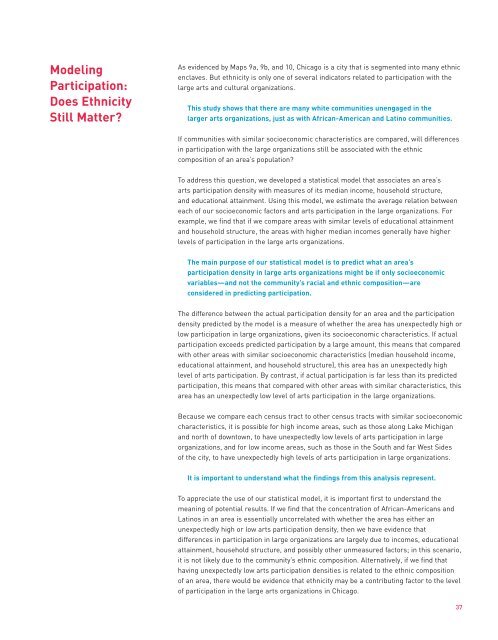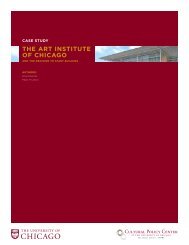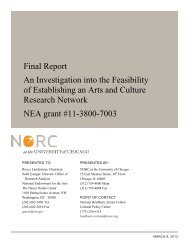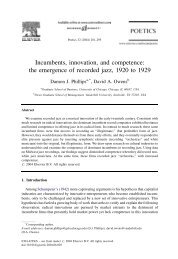Mapping Cultural Participation in Chicago - Cultural Policy Center
Mapping Cultural Participation in Chicago - Cultural Policy Center
Mapping Cultural Participation in Chicago - Cultural Policy Center
Create successful ePaper yourself
Turn your PDF publications into a flip-book with our unique Google optimized e-Paper software.
Model<strong>in</strong>g<strong>Participation</strong>:Does EthnicityStill Matter?As evidenced by Maps 9a, 9b, and 10, <strong>Chicago</strong> is a city that is segmented <strong>in</strong>to many ethnicenclaves. But ethnicity is only one of several <strong>in</strong>dicators related to participation with thelarge arts and cultural organizations.This study shows that there are many white communities unengaged <strong>in</strong> thelarger arts organizations, just as with African-American and Lat<strong>in</strong>o communities.If communities with similar socioeconomic characteristics are compared, will differences<strong>in</strong> participation with the large organizations still be associated with the ethniccomposition of an area’s population?To address this question, we developed a statistical model that associates an area’sarts participation density with measures of its median <strong>in</strong>come, household structure,and educational atta<strong>in</strong>ment. Us<strong>in</strong>g this model, we estimate the average relation betweeneach of our socioeconomic factors and arts participation <strong>in</strong> the large organizations. Forexample, we f<strong>in</strong>d that if we compare areas with similar levels of educational atta<strong>in</strong>mentand household structure, the areas with higher median <strong>in</strong>comes generally have higherlevels of participation <strong>in</strong> the large arts organizations.The ma<strong>in</strong> purpose of our statistical model is to predict what an area’sparticipation density <strong>in</strong> large arts organizations might be if only socioeconomicvariables—and not the community’s racial and ethnic composition—areconsidered <strong>in</strong> predict<strong>in</strong>g participation.The difference between the actual participation density for an area and the participationdensity predicted by the model is a measure of whether the area has unexpectedly high orlow participation <strong>in</strong> large organizations, given its socioeconomic characteristics. If actualparticipation exceeds predicted participation by a large amount, this means that comparedwith other areas with similar socioeconomic characteristics (median household <strong>in</strong>come,educational atta<strong>in</strong>ment, and household structure), this area has an unexpectedly highlevel of arts participation. By contrast, if actual participation is far less than its predictedparticipation, this means that compared with other areas with similar characteristics, thisarea has an unexpectedly low level of arts participation <strong>in</strong> the large organizations.Because we compare each census tract to other census tracts with similar socioeconomiccharacteristics, it is possible for high <strong>in</strong>come areas, such as those along Lake Michiganand north of downtown, to have unexpectedly low levels of arts participation <strong>in</strong> largeorganizations, and for low <strong>in</strong>come areas, such as those <strong>in</strong> the South and far West Sidesof the city, to have unexpectedly high levels of arts participation <strong>in</strong> large organizations.It is important to understand what the f<strong>in</strong>d<strong>in</strong>gs from this analysis represent.To appreciate the use of our statistical model, it is important first to understand themean<strong>in</strong>g of potential results. If we f<strong>in</strong>d that the concentration of African-Americans andLat<strong>in</strong>os <strong>in</strong> an area is essentially uncorrelated with whether the area has either anunexpectedly high or low arts participation density, then we have evidence thatdifferences <strong>in</strong> participation <strong>in</strong> large organizations are largely due to <strong>in</strong>comes, educationalatta<strong>in</strong>ment, household structure, and possibly other unmeasured factors; <strong>in</strong> this scenario,it is not likely due to the community’s ethnic composition. Alternatively, if we f<strong>in</strong>d thathav<strong>in</strong>g unexpectedly low arts participation densities is related to the ethnic compositionof an area, there would be evidence that ethnicity may be a contribut<strong>in</strong>g factor to the levelof participation <strong>in</strong> the large arts organizations <strong>in</strong> <strong>Chicago</strong>.37









